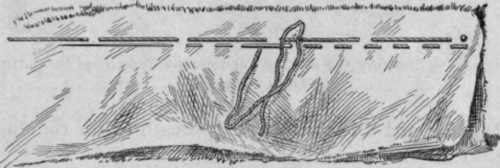Running
Description
This section is from the book "School Needlework. A Course of Study in Sewing designed for use in Schools", by Olive C. Hapgood. Also available from Amazon: School Needlework: A Course Of Study In Sewing Designed For Use In Schools.
Running
Running is done by passing the needle in and out of the material at regular intervals.
The rule for running is to take up two threads of the cloth and pass over two threads, but the light in the average school-room does not permit this, nor is it wise to strain the eyes trying to do so. The general principle is to pass over as much of the cloth as you take up.
Materials
No. 8 needle, No. 50 thread, and a half-yard strip of cotton cloth, doubled and basted. Running Practise Drill No. 3 (page 15).
1. Make a small knot in the thread.
2. Hold the work in the left hand, between the thumb and cushion of the forefinger, as in Fig. 7 (page 15).
3. Sew directly below the basting.
4. Insert the needle between the edges of the seam, at the right-hand corner, and take the stitches (Fig. 21) over the cushion of the left forefinger, as in Drill No. 3 (page 15).

Fig. 21. - Showing the stitches, and the needle in position.
5. Fasten, by putting the needle through to the under side, and taking two or three stitches in the same place.
6. Join the thread, by sewing over the last stitches, or by making a knot and concealing it between the edges of the seam.
Suggestions
To avoid puckering in running, begin at the right hand and smooth the seam between the left thumb and forefinger. Running is used for seams, which do not require great strength, also for tucking.
How is running done? What is the principle to be followed in running? How is the work held? Where are the stitches taken? Where is the needle inserted? How should the stitches be taken? How should the thread be fastened? How should the thread be joined? When is running used?
Continue to:


